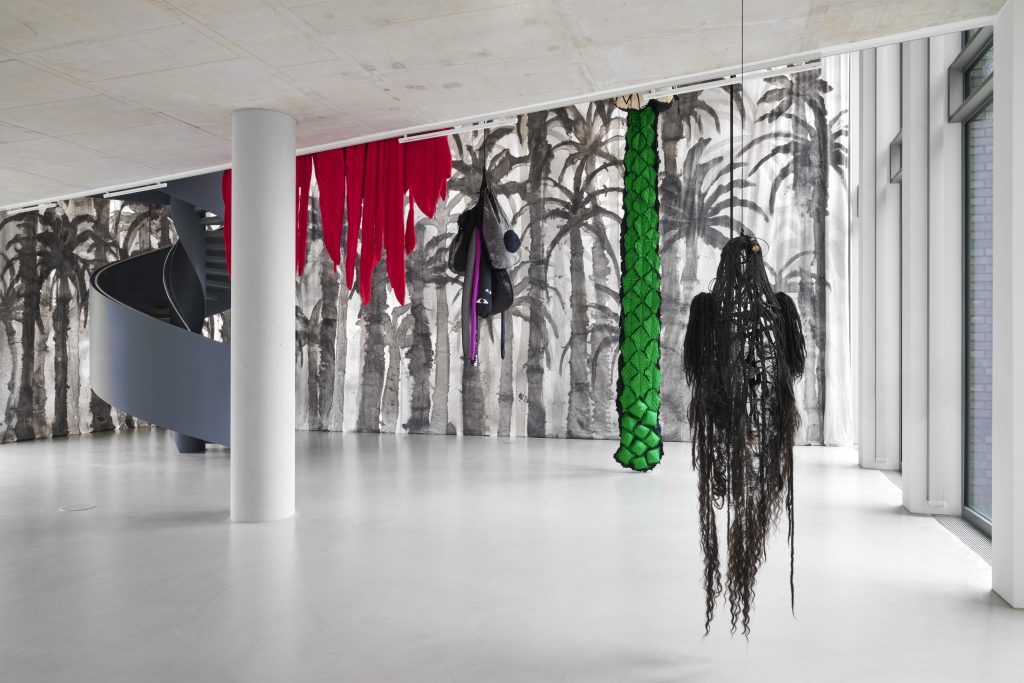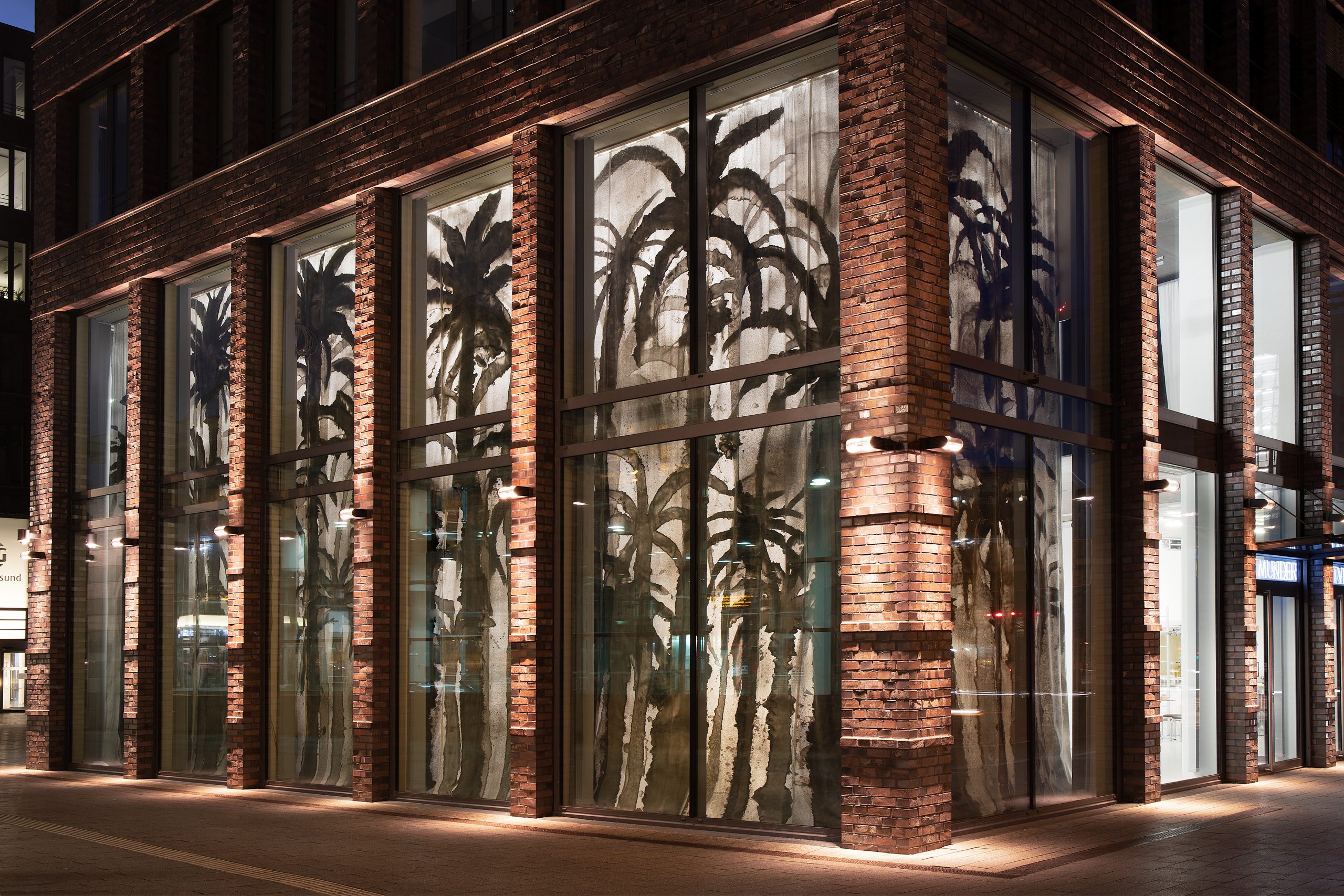Through the media of hair and fabric, Silent Voices in a Palm Grove, an exhibition by Hoda Tawakol at the Dortmunder Kunstverein, braids together stories of female strength and struggle.
To Hoda Tawakol, the image of a palm tree represents much more than a visual marker of Earth’s paradise. In the French-Egyptian artist’s eyes, the Arecaceaen plant embodies a home away from home, a site of motherly strength and nourishment, and the source of generational memory cultivated and tended over many years. In her first institutional solo exhibition, Silent Voices in a Palm Grove, curated by Rebekka Seubert at the Dortmunder Kunstverein, Tawakol creates her own palm sanctuary where counternarratives of female resilience and women’s struggles are seen and woven through hair and fabric.
Tawakol’s titular palm haunt is visible from afar. The newly commissioned Palm Grove #1 (2023), a beige 8 x 19-metre-long curtain, spans half of the monumental glass facade of the space. A dense group of towering, blurry palm trees painted in Chinese ink on the fabric extends from the ground to the ceiling, sheltering visitors from outside view. The artist’s familiarity with the exotic tree species extends beyond the visual. Born in Europe to an Egyptian family, she frequently sought out botanical gardens in Paris and Frankfurt to spend time with the palm trees that belonged to her ‘other’ home and which now form part of her hybrid artistic vocabulary.
Near the exhibition entrance, visitors are greeted by Warrior #2 (2011), an intricately woven body-shaped sculpture made of dark synthetic hair, metal and resin. The imposing, hollow creature hovers above the ground like a solitary guard, sworn to protect with its shell of solidified braids. To its left, smaller series of hair grids on the wall attest to Tawakol’s unceasing practice of braided politics. Much like her Warrior, the mask-like sculptures of Hair and Shebbak, produced between 2011 and 2014, advocate for hair as armour instead of weakness. Hair #7 (2014), for instance, proposes an elaborately braided red headpiece instead of a headscarf – the novel accessory of the contemporary female fighter. The show of hair as a symbol of female emancipation in Middle Eastern societies has long been a thematic focus in Tawakol’s work. With the ebbing of circulating images of burning hijabs and silent protests from the reignited Iranian women’s struggle, the artist’s decade-long hair series is a timely addition to the exhibition, and a harbinger of caution: the fight against oppressive patriarchal regimes – whether in Iran, Egypt or women’s homes elsewhere – is far from over.
The patriarchy is not predator, but prey in Tawakol’s textile cosmos. Drawing from the traditional Middle Eastern men’s sport of falconry – a potentially unsettling hobby of training falcons to hunt at their human master’s will – the artist conceived of a series of supersized, dangling lures to attract her human viewers in Dortmund. Whereas some parts of the chunky fabric lumps resemble flamboyant variants of actual bird lures – long, squishy tails in a patchwork of black, purple, and glittery blue textiles dominate Lure #27 and #28 (both 2023) – others hint at more humanoid shapes. Lure #25 (2021–23), sewn from satin-like fibre, bears an explicitly feminine silhouette with an elongated bosom featuring intricate seamwork on the front and a protruding bottom on the backside. The voluptuous sculpture flips the script on the lures’ voyeuristic peek-a-boo as, adorned with a lanky black palm tree and eyes on the softly rounded back, the viewers’ inadvertently lingering gaze is reflected right back at them – Mother Nature sees all.

Tawakol’s play of scale and sight continues on the space’s second level. Behind the large, blood-red textile Jungle #7 (2023) on the upper railing, visitors enter the installation Salamlek #1 (2023), named after a male meeting space in Islamic architecture. The work is a small copy of the men’s room of the renowned house Bayt Al-Suhaymi in Medieval Cairo, named after its influential former resident, Sheikh Al-Suhaymi. Built with wooden trellis walls that mimic decorative mashrabiyya elements of traditional Islamic buildings, Tawakol’s makeshift communal venue is both visually and symbolically open to all. While viewers are encouraged in a play of visibility within Salamlek’s crisscross walls, ten surrounding human- sized hats of different shapes and colours – modelled after the hoods that are used to numb a falcon’s visual senses – point at the grotesque parallel of controlled and conditioned vision, between human and animal, and men and women.
The significance of the eye takes an intimate, biographical turn in the artist booklet. It is inspired by the mythological story of Horus, god of protection, kingship and the sky, who loses his eye in the fight for the Egyptian throne and, some say, has his sight restored by his mother Isis, goddess of birth, rebirth and magic. Tawakol’s publication The Eyes of My Mothers is a visual exploration of her childhood with three different mother figures across two continents. Double-paged spreads of magnified women’s eyes stare back from the grainy, light blue pages, each more watchful than the previous. On the centre page, the artist recounts her hybrid upbringing and the inherently fractured relation to womanhood that the tripartite guardianship brought about: “Being raised by a triad of mothers, I was left with a fragmented vision of a woman, creating a paradox of overload and absence, paired with a need to let the feminine disappear and simultaneously preserve and repossess it.”
The fluidity of the artist’s works – between strength and softness, brutality and sensuality – sabotages straightforward answers to Tawakol’s political and personal questions. In the Palm Grove, sculptural creatures are neither male nor female. They undermine a strict reading of gender, much like natural palm trees, which are claimed by some to change sex according to the needs of their grove. The artist’s hair grids and plump, colourful textiles exert a visual play of push-and-pull, a humorous tension between the tactile magnetism that lulls their viewers and the startling realisation of one’s own social and instinctual carnality. Her broad symbolic gestures and engaging theatrical staging are open to ruminations on feminine force, privileged vision and the power of places rooted in care, healing and tenacity. At dusk, Tawakol’s Silent Voices can be heard loud and clear. The institution’s light projects its palm trees onto the neighbouring streets, like a beckoning call: the Grove is safe and open to all.
Silent Voices in a Palm Grove runs until 11 June
This review first appeared in Canvas 108: The Root of It All



